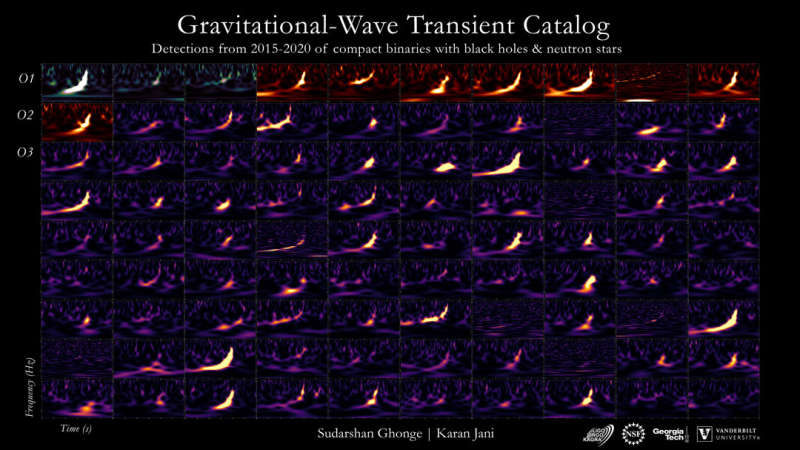
|
Credit & Copyright: NSF,
LIGO,
VIRGO,
KAGRA,
Georgia Tech,
Vanderbilt U.;
Graphic :
Sudarshan Ghonge &
Karan Jani
Explanation:
Every time two massive
black holes collide,
a loud chirping sound is broadcast out into the universe in
gravitational waves.
Humanity has only had the technology to hear
these unusual chirps for the past seven years,
but since then we have heard about 90 -- during the first three observing runs.
Featured above are the spectrograms
-- plots of gravitational-wave frequency versus time --
of these 90 as detected by the giant detectors of
LIGO (in the
USA),
VIRGO
(in Europe), and
KAGRA
(in Japan).
The more energy received on
Earth
from a collision, the
brighter it appears on the graphic.
Among many science firsts, these
gravitational-radiation chirps
are giving humanity an unprecedented
inventory of black holes and neutron stars, and a new way to
measure the expansion rate of our universe.
A fourth gravitational wave observing run with
increased sensitivity is currently planned to begin in 2022 December.
|
January February March April May June July August September October November December |
| ||||||||||||||||||||||||||||||||||||||||||||||||
NASA Web Site Statements, Warnings, and Disclaimers
NASA Official: Jay Norris. Specific rights apply.
A service of: LHEA at NASA / GSFC
& Michigan Tech. U.
Based on Astronomy Picture
Of the Day
Publications with keywords: gravitational radiation
Publications with words: gravitational radiation
See also:
- APOD: 2025 September 24 Á GW250114: Rotating Black Holes Collide
- Simulation: Two Black Holes Merge
- APOD: 2023 June 29 Á A Message from the Gravitational Universe
- GW200115: Simulation of a Black Hole Merging with a Neutron Star
- When Black Holes Collide
- Fifty Gravitational Wave Events Illustrated
- GW190521: Unexpected Black Holes Collide
